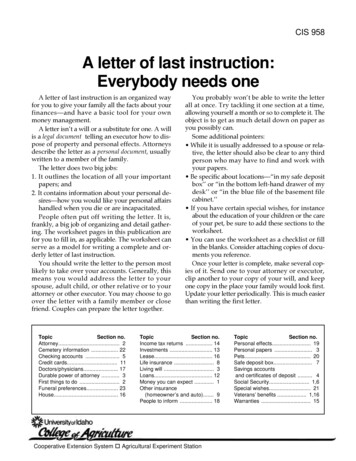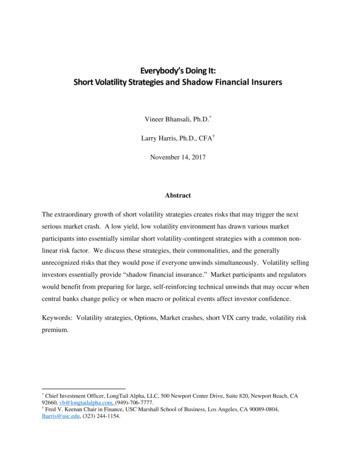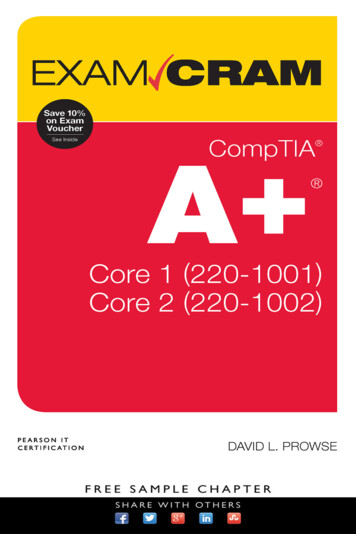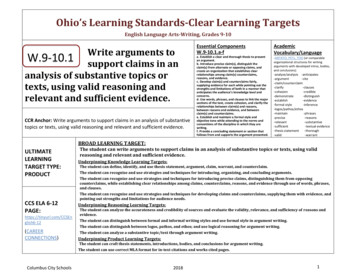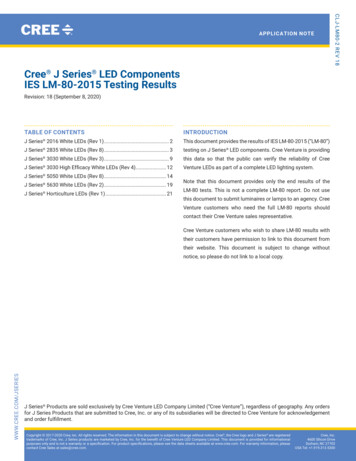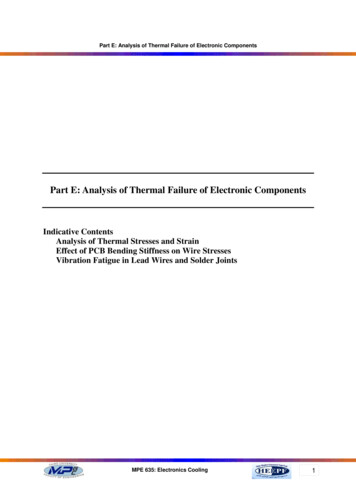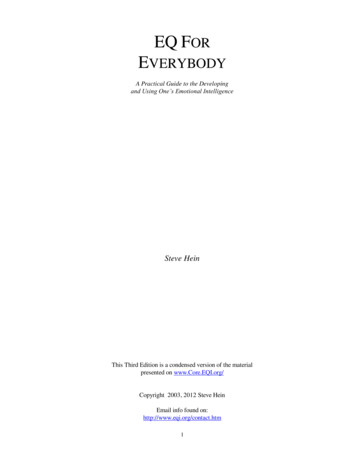
Transcription
EQ FOREVERYBODYA Practical Guide to the Developingand Using One’s Emotional IntelligenceSteve HeinThis Third Edition is a condensed version of the materialpresented on www.Core.EQI.org/Copyright 2003, 2012 Steve HeinEmail info found on:http://www.eqi.org/contact.htm1
INTRODUCTIONA Few of My Underlying BeliefsI believe we would all be happier and healthier, and increase our chances of survival as a species if we followed one simpleprinciple:Mutual respect for each other's feelings.To get to this point, though, we first need two things. We need to:1. Know how we feel.2. Communicate how we feel.Once we have mastered the first two steps, we can begin work on the lifelong challenge of respecting each other's oftenconflicting feelings and needs. Success requires a healthy development of our emotional intelligence.I also believe things work better when people act voluntarily rather than out of force, coercion, bribery or fear.I believe our emotions provide us with the means to know ourselves and that this self-knowledge is the key to our happiness.I believe children start out basically happy, empathetic and "good" and that most unhappiness in children and adults is a directresult of unmet needs. Further, I believe that in developed countries most of these unmet needs are unmet emotional needs, notunmet physical needs.The Importance of Emotional IntelligenceI have lived most of my life in the United States, so it is with regret that I say that the USA is a world leader in the amount ofunhealthy, socially- and self-destructive behavior such as drug abuse, violence and murder. This is not because of a lack ofopportunity, wealth or cognitive intelligence. Instead, I believe it is due to a combination of unmet emotional needs andabnormally developed emotional intelligence. I believe this combination is also a leading cause of adolescent depression, selfharm and suicide. It is my hope that the ideas in this booklet will one day help to reverse the unhealthy trends seen in the USAand many other countries around the world.The booklet is organized into alphabetically-arranged sections. As a guide, I suggest you begin with reading the sections titledDefinitions of Emotional Intelligence, Awareness, Empathy, Validation and Emotional Literacy. Next I would suggest Respectand Invalidation.Thank you for your interest in my work.Steve Hein2012 Note from Steve – This is a slightly revised edition of the 2003 booklet. I decided to distribute it freely to help my ideasspread to the places they are needed in the world. You may copy, translate and share this freely.2
ANGER The ultimate test of our emotional intelligence may be in the way we handle anger. Do we use it in productive or counterproductive ways? Does our anger lengthen or shorten our lives? Here are some of my thoughts.Overview of AngerThere are several important things to remember when speaking of anger:1. It is a powerful survival tool2. It is a source of energy3. It is a secondary emotion4. In anger mode the brain downshifts5. Prolonged anger is very unhealthy6. Repressed anger is also very unhealthyNature has developed the emotional state we call “anger” to help us stay alive. Anger sends signals to all parts of our body tohelp us fight or flee. It energizes us to prepare us for action. Millions of years ago, our threats came mostly in the form ofattacks by wild animals who wanted to eat us. Now we more often feel psychologically attacked. (Though this evolutionarytrend is reversing in those countries where there is an increase in violence and the use of handguns.)When we feel energized by anger, it is smart to ask ourselves how we put this energy to the most productive use. As with theuse of other forms of energy such as electricity or oil, we want to use it efficiently, not wastefully.Primary vs. Secondary FeelingsPerhaps the most helpful thing to remember about anger is that it is a secondary emotion. A primary feeling is what is feltimmediately before we feel angry. We always feel something else first. One might first feel afraid, attacked, offended,disrespected, forced, controlled, trapped, interrogated, or pressured. If any of these feelings are intense enough, we think of theemotion as anger.A critical point to remember about secondary feelings is that they do not identify the unmet emotional need (UEN). When all Ican say is “I feel angry”, neither I nor any one else knows what would help me feel better. An amazingly simple, but effectivetechnique, then, is to always identify the primary emotion.Here is an example. Assume someone wants us to do something we prefer not to do. At first we feel a little pressured but notenough to get angry. When they keep pushing us, we begin to get irritated. If they continue, we get “angry.”An effective way to avoid getting angry in many cases is simply to express your initial feeling, before it has been elevated to thepoint of anger. This helps keep the brain in balance and out of the more volatile mode where it has downshifted to a moreprimitive and physiological response.Anger as a Response to FearOne of the primitive functions of an animal’s response to fear is to frighten away the attacker. But in modern human life, weoften frighten away those who we need and care about most. Besides this, prolonged anger has clear health consequences.According to Dr. Herbert Benson, these include heart attacks, hardening of the arteries, strokes, hypertension, high bloodpressure, heart rate changes and metabolism, muscle and respiratory problems. (The Relaxation Response, 1975)Responding To and Learning From AngerAnger is an intense emotion. It is evidence that we feel strongly about something. As with every emotion, it has a lesson for us.It can teach us what we value, what we need, what we lack, what we believe and what our insecurities are. It can help us3
become more aware of what we feel strongly about and which emotional needs are important to us. One way to learn from angeris shown in the example below:Instead of saying,She never should have done that. I can't believe how irresponsible, insensitive and inconsiderate she is. What acold-hearted, evil witch she is.a more productive response is:Wow, I am really upset by this. Why does it bother me so much? What specifically am I feeling? What are myprimary feelings? What need do I have that is not being met? What principles of mine have been violated?From the answers to these questions, we can decide what course of action to take in view of what our goals are. Simply beingaware that we have multiple options and that we can decide to pick the best one helps soothe the anger. It may help, forinstance, to ask if we really want to frighten away the person we are angry at. As soon as we “upshift” to the upper part of ourbrain, (see section on the brain) and begin to think about our options and their consequences, and make appropriate plans, westart to feel more in control and less threatened. We get out of the automatic stimulus-response mode and realize that we havechoices.Remember that there is a space between stimulus and response, and in this space lies our power to choose the optionwhich is in our long-term best interests.1Simply remembering that we have a choice helps us feel more in control. Not surprisingly, studies show that people feel betterand are healthier when they have a sense of control over their lives. This is where the balance between upper brain and lowerbrain comes in. High EQ suggests that we channel our anger in productive ways to help us achieve our goals rather than tosabotage them. Keeping our goals clearly in mind at all times helps us accomplish this.Here are some suggestions for responding to your anger:1.2.3.4.5.6.7.Ask what you are afraid of.Ask what feelings preceded the anger.Ask what other feelings you are feeling.Ask what you are trying to control.Ask what you can control.Consider your options.Choose the one which will bring you the most long term happiness.Finally, here is a technique I sometimes use to help me cope with “anger” (if I haven’t already “downshifted” to a purelyreactive animal instinct state). When I catch myself starting to say “I feel angry” or “I am starting to get really pissed off”, I tryto remember to say instead, “I feel really energized”. Then I ask myself how I want to channel my energy to its best use. It is asimple little technique, but it makes a big difference in how I feel and how I respond, when I can remember to do it!1Borrowed from Stephen Covey who borrowed it from someone else!4
AWARENESSWithout awareness of our feelings and what causes them, it will be difficult for us to lead a happy life. And we need awarenessof our own feelings to help us feel empathy. Here are three aspects of awareness: acknowledgment, acceptance andidentification.Acknowledging FeelingsIn defining emotional intelligence, John Mayer and Peter Salovey say our emotions “direct our attention to importantinformation in our environment.” They send us signals through the mind and through the body. If we do not acknowledge them,they relentlessly continue to pursue our attention. Nature’s purpose for negative emotions is to call our attention to the causes ofour negative feelings so we may take corrective action. Our feelings are something like the inner voices that speak to us. Tomake healthy and wise choices, we need to find a healthy balance between listening to our feelings and listening to our intellect.Identifying Specific FeelingsParticularly with negative feelings, it is very important to identify the feeling as specifically as possible. For example, whenfeeling “angry”, it helps to narrow down the feeling or feelings which preceded the anger. The more specific we are, the moreaccurate we can be in identifying the unmet emotional need and taking appropriate corrective action. (See section titled NegativeEmotions.)Research indicates that just the simple act of naming a feeling helps us feel better. This happens for two reasons. First, we havea natural fear of the unknown. When we label our feeling, we move it from the unknown to the known and thus we help make itless scary and more manageable. Second, when we label it, we are using the upper part of the brain. We are actually diffusingand moving the chemicals from their concentration in our emotional brains to our reasoning brain. By beginning to think aboutour feeling, we are also taking the next step towards solving our problem. When our thoughts are clear, this helps us feel morecalm and in control.5
THE BRAIN Science continues to provide us with new information concerning the development and functioning of the brain. For example,we are learning more about the relationship between the cognitive and emotional centers of the brain.The Upper and Lower BrainsAccording to recent brain research, emotions begin primarily in our lower brain, just above the spinal cord. This is the part ofour brain that most closely resembles other animals, and which is often called the reptilian brain. The reptilian brain is olderthan our upper brain in evolutionary terms. Over time, the brain has grown from the lower, back portion of the head to theupper, front portion.The Baby’s BrainWhen a baby is born, his brain is more developed in the lower region than in the upper. Included in the lower region is theemotional center of the brain, the amygdala. The implication of this is that babies and young children are storing emotionalmemories long before they have the words or logic to go with them. Before we could think, we were already learning to senseand feel. Our feelings precede our thoughts both in evolutionary and developmental terms. This may help explain why our “gutfeeling” is so often correct.Recent scientific innovations have enabled us to actually watch the brain at work when it is thinking and feeling. We can seewhat happens when a child is frightened or intellectually stimulated. We can watch the connections being formed. This newinformation is making it more clear that our adult caregivers literally wire our emotional brains when we are young, setting acourse of security and empathy or insecurity and insensitivity. 22For a more complete discussion, see Goleman’s Emotional Intelligence, chapters 1,2 and 126
CONFLICT RESOLUTION Nearly all conflicts involve underlying emotional issues. The stronger the feelings, the more difficult the resolution. To resolveconflicts, then, it is absolutely necessary to address the feelings of all parties. Listed below is a conflict resolution model basedon Emotional Intelligence. The basic steps are outlined below:Seek to Understand-Validate each person's feeling.Confirm a willingness to solve problem.Seek understanding of the cause of the feeling.Confirm accurate understanding; paraphraseIdentify the underlying unmet emotional needs.Show empathy.Ask the powerful and positive question:What would help you feel better?Seek to Be Understood-Share your feelings & needs.Confirm accurate reception & understanding.Mutually Generate Options & Resolutions-Brainstorm solutions (while withholding evaluation/judgment).Discuss each parties feelings about alternatives.Make selection which maximizes positive feelings and minimizes negative feelings.Hints:1. Resist the inclination to focus on “what happened” at the neglect of the feelings behind the behavior.2. Allow the least powerful person the lead role in generating and evaluating options. This helps balance the power.7
DEFINITIONS OF EMOTIONAL INTELLIGENCE I have developed the following definition of EI which is based on the Mayer Salovey four branch model of EI.1. Emotional Perception and Expression - the ability to accurately identify and express feelings The ability for self-awareness; to be aware of your own feelings as they are occurring.The ability to become emotionally literate.The ability to learn to identify and label specific feelings in yourself and others andThe ability to clearly and directly communicate and discuss
The ultimate test of our emotional intelligence may be in the way we handle anger. Do we use it in productive or counter-productive ways? Does our anger lengthen or shorten our lives? Here are some of my thoughts. Overview of Anger There are several important things to remember when speaking of anger: 1. It is a powerful survival tool 2. It is a source of energy 3. It is a secondary emotion 4 .
